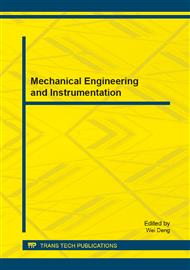p.133
p.139
p.145
p.150
p.155
p.164
p.171
p.177
p.182
Fault Mechanism Analysis and Characteristic Extraction for Multi-Disc Clutch
Abstract:
The thermo-elastic coupling model of clutch friction pair is established by the thermoelastic instability theory to acquire the basic process of friction disc warp due to hot agglomeration; according to this process, thought of reflecting initial phase clutch fault by observing the partial deformation generated by hot spots is proposed in this paper. And based on this thought, the multi-disc clutch dynamics simulation model is established to acquire the dynamic characteristics existing on the friction pair when tiny deformation happens; according to vibration characteristics of this characteristics and the feature that the interference noise of the high frequency section of the transmission system is comparatively light, and based on the analysis on the difference of frequency spectrum of the high frequency section before and after shifting gears, a new kind of initial phase multi-disc clutch fault diagnosing method based on vibration signal analysis is proposed. The test results further prove that, this method can be used to extract the impact vibration generated by tiny deformation happened on the friction pair, and is hopeful to be used in the practical engineering of initial phase multi-disc clutch fault diagnosing.
Info:
Periodical:
Pages:
155-163
Citation:
Online since:
February 2014
Price:
Сopyright:
© 2014 Trans Tech Publications Ltd. All Rights Reserved
Share:
Citation:


